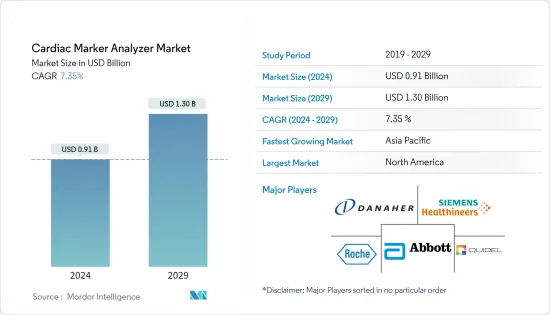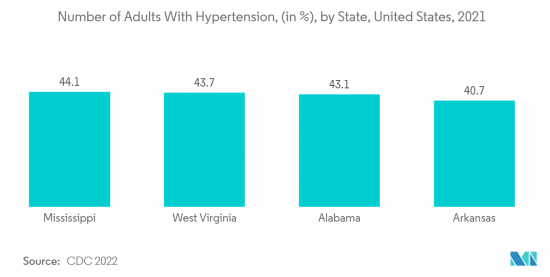
심장 마커 분석기 시장 규모는 2024년에 9억 1,000만 달러로 추정되며, 2029년에는 13억 달러에 달할 것으로 예측되며, 예측 기간(2024-2029년) CAGR은 7.35%로 성장할 전망입니다.

COVID-19 팬데믹은 조사 대상 시장에 큰 긍정적인 영향을 미쳤습니다. 전 세계에서 팬데믹 기간 중 대상 집단의 심혈관 질환(CVDs) 위험이 증가했습니다. 예를 들어 2022년 3월 JAMA에 게재된 연구 논문에 따르면 2020년 3월부터 2021년 1월까지 COVID-19 환자를 대상으로 한 대규모 집단 조사 결과, COVID-19 환자는 뇌혈관 질환, 부정맥, 허혈성 및 비허혈성 심장 질환, 심막염, 심근염, 심부전, 혈전 색전증 등 다양한 심혈관 질환이 자주 발견되었다고 합니다. 이로 인해 전염병 기간 중 심장 진단에 대한 수요와 진단 목적의 심장 마커 사용이 증가했습니다. 그러나 현재 시장은 이미 팬데믹 이전 상태로 돌아갔으며, 향후 수년간 강력한 성장이 예상됩니다.
전 세계에서 CVD의 유병률 증가와 심장 질환의 오진 예방에 대한 관심이 높아진 것이 시장 성장의 주요 요인으로 꼽힙니다. 예를 들어 2021년 8월 베링거인겔하임(Boehringer Ingelheim GmbH)이 발표한 보도자료에 따르면 전 세계에서 매년 약 6,000만 명 이상이 심부전으로 알려진 만성적이고 장애를 동반한 심신 대사성 질환을 앓고 있습니다. 또한 WHO의 2021년 6월 업데이트에 따르면 CVD의 부담이 전 세계에서 증가하고 있으며, 특히 중저소득 국가에서 증가하고 있는 것으로 나타났습니다. 따라서 질병 부담을 억제하기 위해서는 더 나은 진단이 필요합니다. 따라서 심장 마커에 대한 수요가 발생하고, CVD 및 관련 질환의 원인과 위험 요인을 분석할 수 있는 첨단 장비의 활용이 필요합니다. 이에 따라 심장 마커 분석 장비에 대한 세계 수요가 증가하고 있으며, 시장 성장을 가속할 것으로 예상됩니다.
또한 CVD로 인한 입원 및 중환자실 입원이 증가함에 따라 더 나은 질병 진단을 위해 심장 마커를 사용하고자 하는 수요가 증가하고 있습니다. 예를 들어 AIHW가 2022년 5월 발표한 데이터에 따르면 1,180만 건의 입원 중 중환자실 입원은 7%, 응급실 입원은 3.8%를 차지했습니다. 이처럼 CVD 환자의 응급실 및 중환자실 입원이 많기 때문에 마커를 판독하여 질병을 더 잘 진단할 수 있는 심장 마커 분석기를 개발하여 사용할 수 있도록 해야 할 필요성이 대두되고 있습니다. 이는 이 시장의 성장을 가속할 것으로 예상됩니다.
따라서 위의 요인으로 인해 예측 기간 중 시장은 크게 성장할 것으로 예상됩니다. 그러나 엄격한 규제 과정과 높은 장비 비용은 조사 기간 중 시장 성장을 억제할 것으로 예상됩니다.
면역 형광 분석기(IFA) 부문은 심장 마커 분석기 시장에서 가장 높은 점유율을 차지할 것으로 예상됩니다. 다른 분석기기에 비해 IFA는 심장 질환의 조기 진단을 위한 표준으로 사용되고 있기 때문입니다. 또한 전혈, 혈청, 혈장내 바이오마커 농도를 정량화하여 임상 진단에 도움을 줄 수 있으므로 IFA 분석기에 대한 수요가 증가하고 있습니다. 이에 따라 이 분야는 성장세가 지속될 것으로 예상됩니다.
주요 심혈관 질환 중 심근경색(MI)은 이환율과 사망률이 높은 질환입니다. 따라서 심근경색 및 기타 심각한 결과의 발생을 예방하기 위해서는 적절한 바이오마커를 가능한 한 빨리 식별하는 것이 매우 중요합니다. 트로포닌 i, NT-proBNP, h-FABP, CK-MB, 미오글로빈과 같은 심장 마커를 포함한 다양한 유형의 바이오마커를 IFA 분석기를 통해 검사할 수 있습니다.
2021년 8월 PMC에 게재된 논문에 따르면 심근 트로포닌은 근육의 조절과 수축의 중요한 컴포넌트이며, 높은 특이성으로 인해 심장 질환의 가장 특이적인 바이오마커 중 하나라고 합니다. 이 정보원에 따르면 많은 진단 기술이 개발되었지만, IFA는 MI 후 심근 트로포닌을 빠르고, 정확하고, 민감하게 측정할 수 있는 것으로 나타났다고 합니다. 따라서 이러한 연구는 이 부문의 성장을 가속하고 있습니다. 따라서 위의 요인으로 인해이 부문은 예측 기간 중 크게 성장할 것으로 예상됩니다.

북미는 예측 기간 중 전체 심장 마커 분석기 시장을 지배할 것으로 예상됩니다. 성장의 주요 요인은 좌식 생활 습관, 운동 부족, 적절한 식습관 부족, 불안, 스트레스로 인해 관상동맥 질환, 뇌졸중, 심방세동과 같은 여러 심혈관 질환의 유병률이 증가하고 있습니다. 미국은 기타 지역 국가들 중에서도 시장 성장에 크게 기여하고 있습니다.
다양한 자료와 연구에 따르면 트로포닌은 급성관상동맥증후군(ACS)이 의심되는 환자의 진단과 위험도 분류에 심장 바이오마커로 자주 사용됩니다. 심장마비와 같이 심장 근육이 손상되면 트로포닌 I 또는 T 단백질이 방출됩니다. 혈액내 트로포닌 I 또는 T 수치는 면역측정 분석기를 이용한 트로포닌 검사로 측정합니다. 이처럼 북미 각국에서는 심장병 환자가 증가함에 따라 심장 마커에 대한 수요가 증가하고 있으며, 이는 시장 성장을 가속할 것으로 예상됩니다. 예를 들어 Cedars-Sinai의 2022년 1월 업데이트에 따르면 관상동맥우회술(CABG)은 관상동맥우회술 또는 우회수술이라고도 하며, 미국에서 매년 30만 명 이상이 성공적으로 우회수술을 받는 심장수술 중 가장 흔한 유형입니다.
또한 CDC의 2022년 7월 업데이트에 따르면 관상동맥성 심장병은 심장병 중 가장 흔한 유형으로 미국내 20세 이상 성인 중 약 2,010만 명이 앓고 있는 것으로 나타났습니다. 또한 위의 출처에 따르면 40초마다 1명이 심장마비가 발생하며, 미국에서는 매년 약 805,000명이 심장마비를 앓고 있습니다. 이처럼 심혈관 질환의 높은 부담은 더 나은 치료를 위한 고급 진단 옵션의 가용성을 요구하여 심장 마커에 대한 수요를 촉진하고 있습니다. 이에 따라 심장 마커 분석 장비에 대한 수요가 증가하여 이 지역 시장 성장에 박차를 가할 것으로 예상됩니다.
따라서 위의 요인으로 인해 북미에서는 예측 기간 중 큰 폭의 성장이 예상됩니다.
심장 마커 분석기 시장은 경쟁이 치열하며 전 세계에서 여러 주요 기업이 존재합니다. 주요 업체들은 기존 제품에 대응하기 위해 신제품을 개발하고 있으며, 다른 업체들은 세계 입지를 확대하기 위해 시장내 다른 업체를 인수하거나 제휴하고 있습니다. 시장에 참여하고 있는 주요 기업에는 F. Hoffmann-La Roche Ltd., Abbott Laboratories, Quidel Corporation, CardioGenics Holdings Inc., LSI Medience Corporation 등이 있습니다.

The Cardiac Marker Analyzer Market size is estimated at USD 0.91 billion in 2024, and is expected to reach USD 1.30 billion by 2029, growing at a CAGR of 7.35% during the forecast period (2024-2029).
The COVID-19 pandemic had a significant positive impact on the market studied. Globally, the risk of cardiovascular diseases (CVDs) among the target population increased during the pandemic. For instance, a research article published in JAMA in March 2022 stated that when the large pool study was conducted among COVID-19 patients from March 2020 to January 2021, various cardiovascular diseases, such as cerebrovascular disorders, dysrhythmias, ischemic and non-ischemic heart disease, pericarditis, myocarditis, heart failure, and thromboembolic illness, were frequently found in COVID-19 patients. Thus, the demand for cardiac diagnosis and the use of cardiac markers for diagnostic purposes increased during the pandemic. However, currently, the market has reached its pre-pandemic nature and is expected to witness strong growth in the coming years.
The rising prevalence of CVDs globally and the growing emphasis on preventing misdiagnoses of cardiac conditions are the major factors that contribute to the market's growth. For instance, as per a press release by Boehringer Ingelheim GmbH in August 2021, nearly 60 million people or more were affected by the chronic, disabling cardio-renal-metabolic illness known as heart failure across the world every year. In addition, the June 2021 update by WHO showed that the burden of CVD rose globally, especially in low- and middle-income countries. Thus, to control the disease burden, a better diagnosis is required. This creates a demand for cardiac markers, which necessitates the availability of advanced devices capable of analyzing the cause or risk factors of CVD and associated diseases. As a result, the global demand for cardiac marker analyzers is increasing, which is expected to propel market growth.
Furthermore, the increasing number of hospital admissions and critical care unit admissions due to CVD creates a demand for the availability of cardiac markers for better disease diagnosis. For instance, as per data released by the AIHW in May 2022, out of 11.8 million hospital admissions, 7% involved a stay in intensive care nits, and 3.8% involved emergency room admissions. This high number of admissions of CVD patients in emergency and critical care creates the need for the development and availability of cardiac marker analyzers that can read the markers and result in a better diagnosis of the disease. This is expected to drive the growth of the market studied.
Therefore, due tfactors mentioned aboveactors, the market studied is expected to grow significantly during the forecast period. However, a strict regulatory process and the high cost of the instruments are expected to restrain the market growth during the study period.
The immunofluorescence analyzers (IFA) segment is expected to account for the highest cardiac marker analyzer market share. Compared to other analyzers, their dominance in the revenue share can be attributed to their use as the gold standard for the early diagnosis of cardiac diseases. In addition, owing to their ability to quantify the concentration of biomarkers in whole blood, serum, and plasma to assist clinical diagnosis, there is a growing demand for IFA analyzers. Thus, the segment is expected to witness growth.
Among all major cardiovascular disorders, myocardial infarction (MI) has a high morbidity and mortality rate. Thus, it is crucial to identify the right biomarkers as soon as possible to prevent the occurrence of MI and other serious outcomes. Various types of biomarkers can be tested using IFA analyzers, including the cardiac markers Troponin I, NT-proBNP, h-FABP, CK-MB, myoglobin, and others.
According to an article published in PMC in August 2021, cardiac troponin, a crucial component of muscle control and contraction, was one of the most specific biomarkers for cardiac damage because of its high specificity. The same source stated that numerous diagnostic techniques have been developed, but IFA was discovered to be a quick, precise, and sensitive instrument for determining cardiac troponins post-MI. Thus, such research is fueling the segment's growth. Therefore, owing to the abovementioned factors, the segment is expected to grow significantly during the forecast period.

North America is expected to dominate the overall cardiac marker analyzer market throughout the forecast period. The major factors attributing to the growth are a sedentary lifestyle, a lack of physical activity, a lack of a proper diet, anxiety, and stress, resulting in the growing prevalence of multiple cardiovascular diseases like coronary artery disease, strokes, and atrial fibrillation. The United States contributes significantly to the market's growth among other regional countries.
Various sources and research state that troponin is often used as a cardiac biomarker to diagnose and risk stratification patients with suspected acute coronary syndrome (ACS). When the heart muscle has been damaged, like in the case of a heart attack, these troponin I or T proteins are released. The blood's troponin I or T levels are determined using a troponin test with immunoassay analyzers. Thus, with an increase in cardiac patients in countries across North America, the demand for cardiac markers is increasing, which is expected to fuel the market's growth. For instance, the January 2022 update from Cedars-Sinai showed that coronary artery bypass graft surgery (CABG), also known as coronary artery bypass or bypass surgery, is the most common type of heart surgery, and more than 300,000 people have successful bypass surgery in the United States each year.
In addition, the July 2022 update by the CDC showed that coronary heart disease was the most common type of heart disease, and approximately 20.1 million adults aged 20 and older had the disease in the United States. Additionally, per the source above, every 40 seconds, someone suffers from a heart attack, and nearly 805,000 people in the United States have a heart attack every year. Thus, the high burden of cardiovascular diseases demands the availability of advanced diagnostic options for better treatment, thereby driving the demand for cardiac markers. This is expected to drive the demand for cardiac marker analyzers, fueling market growth in the region.
Hence, due to the abovementioned factors, the market studied is expected to witness significant growth over the forecast period in North America.
The cardiac marker analyzer market is competitive and has several major players globally. The key players are developing novel products to compete with the existing products, while others are acquiring and partnering with the other companies trending in the market to expand their global presence. Some key players operating in the market are F. Hoffmann-La Roche Ltd., Abbott Laboratories, Quidel Corporation, CardioGenics Holdings Inc., and LSI Medience Corporation.